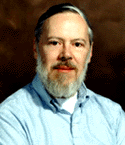Dennis M. Ritchie
Location

- Dennis Ritchie
Bell Labs, Rm 2C-517
600 Mountain Ave.
Murray Hill, New Jersey 07974-0636, USA
- dmr@bell-labs.com
- +1 908-582-3770 (office), +1 908-582-5857 (fax)
History
I work in the
Computing Sciences Research Center
of Bell Labs, and have for a long time.
This experience has been more varied than it
might seem; here's some of the history:

When I joined in 1967, Bell Labs was a corporation jointly owned by
American Telephone and Telegraph Company and its subsidiary
Western Electric. Its official name was Bell Telephone Laboratories, Incorporated.

Soon after, Ken Thompson, together with me and
others, first started work on Unix.
Also soon after, AT&T, which still owned most of the Bell System,
updated its logo (I doubt the events were related).
The new logo just updated the image; corporate structure
remained the same. The material published by us during
the period up to 1984 used this
Bell logo and the name "Bell Laboratories."

In 1984, AT&T, under a negotiated consent decree,
divested the local telephone companies
it had owned and in the process gave up the Bell logo
and the Bell name except in connection with Bell Laboratories.
Bell Telephone Laboratories Inc. was dissolved as a corporation
and became an integrated unit of AT&T.
We lost the Wehrmacht helmet and gained the Deathstar,
and now identified ourselves as working at "AT&T Bell Laboratories."

In 1996, AT&T (this time voluntarily) spun off its systems
and technology organizations into Lucent Technologies, while
AT&T kept the services business. Bell Labs
stayed mostly with Lucent, though some of our colleagues helped
form a new AT&T labs, much as some of us went to Bellcore in 1984.
The new corporate logo usually includes the line "Bell Labs Innovations."
Bell Labs remains a remarkably good place to
do work that has enduring impact over the long run,
no matter what the company, the courts, and PR types decide should
be our name and logo on a given day or year.
Some papers
Some of the papers I get asked about have been converted to
HTML or PostScript or other formats.
For fun there are certain
other incunabula.
- Why Ken had to invent | :
some partially enigmatic advice from Doug McIlroy that dates to 1964.
- An old picture from the archives, with a little
photointerpretation.
- Labscam: a story from 1989,
whose protagonists are a show-biz duo, Plan 9 geeks, and a Nobel laureate.
- VAX over 20+ years, our early
impression of Digital's architecture, with an assessment from Usenet
of 1988.
- `The Development of the C Language', from HOPL II, 1993:
browsable,
or printable PostScript
 Resurrection of two
primeval C compilers from 1972-73,
including source (though you won't be able to compile it today).
Resurrection of two
primeval C compilers from 1972-73,
including source (though you won't be able to compile it today).
- A Memo from 1976 that proposes
buying a machine to which to port Unix, and the kinds of changes that would be needed
in C to make this possible.
- `The Evolution of the Unix Time-sharing System,'
an account of developments during 1968-1973.
browsable,
or printable PostScript
- `A Stream Input/Output System', from AT&T Bell Laboratories
Technical Journal, 1984:
browsable,
or printable PostScript
- `Interprocess Communication in the Ninth Edition Unix System,'
with D. L. Presotto, from Software--Practice and Experience,
19, June 1990.
browsable,
or printable PostScript.
- The entire
Seventh Edition Manual is available on-line,
with not only the man pages but all the papers.
- `The Unix Time-sharing System,' the 1978 BSTJ update
of the 1974 C. ACM article by me and Ken Thompson
originally describing Unix:
browsable,
or printable PostScript
- Users' Reference to B, which describes
the B programming language; it is by Ken Thompson and describes
the PDP-11 version.
- CSTR #8 also describes
the B programming language; it is for the GCOS version
on Honeywell equipment. It is by Johnson and Kernighan.
- The version of the
C Reference Manual (rendered here only in
Postscript, 250KB)
that came with 6th Edition Unix (May 1975), in the second volume entitled
``Documents for Use With the Unix Time-sharing System''.
No updated version of this manual was distributed with the 7th Edition,
since the first edition of the `white book'
K&R
was published about the same time,
and the manual became the book's Appendix A. The structure and even many bits of
wording survived into K&R I and thence into the ANSI/ISO standard
for the language.
- Historical notes (and a manual) on
QED, the ancestor of the Unix
ed and vi editors.
- Notes for a Unix talk circa 1972
- `Variable-size Arrays in C,' a proposal of mine that appeared in
Journal of C Language Translation, but is not the approach adopted
in the C9X draft standard:
browsable,
or printable PostScript
- Insider secrets: Values of beeta will give rise to Dom!
- Unix Programmer's Manual, First Edition (1971)
Page scan or Postscript (via OCR) of life before pipes or grep were invented.
- BCPL Reference Manual by Martin Richards, dated July 1967.
The language described here supplied the basis for much of our own work and that
of others. The linked page discusses the circumstances, while
the files linked under it have the manual itself.
- Dabbling in Cryptography, in which the author finds himself
involved in stronger political forces and higher mathematical creativity than is his wont.
- The
The C Programming Language book has a home page.
It has acquisition information and the current errata list,
and cover art from various translations, but otherwise not much
that's really
 .
.
- Bob Bowles found and scanned a Unix ad from 1981.
See it now; it's not all that big.
- I have lives besides those recorded above.
-
 Links to sites with Unix, C, and other
(generally older) historical material.
Links to sites with Unix, C, and other
(generally older) historical material.
- A Letter from Washington,
an account of the experience of receiving the National Medal of
Technology.
- More to come....
Biography
A brief biography, in first person
instead of obituary style.
Bibliography
bibtex format or
html format .
Last modified: August 21, 1999.






 Resurrection of two
primeval C compilers from 1972-73,
including source (though you won't be able to compile it today).
Resurrection of two
primeval C compilers from 1972-73,
including source (though you won't be able to compile it today).
 .
.
 Links to sites with Unix, C, and other
(generally older) historical material.
Links to sites with Unix, C, and other
(generally older) historical material.